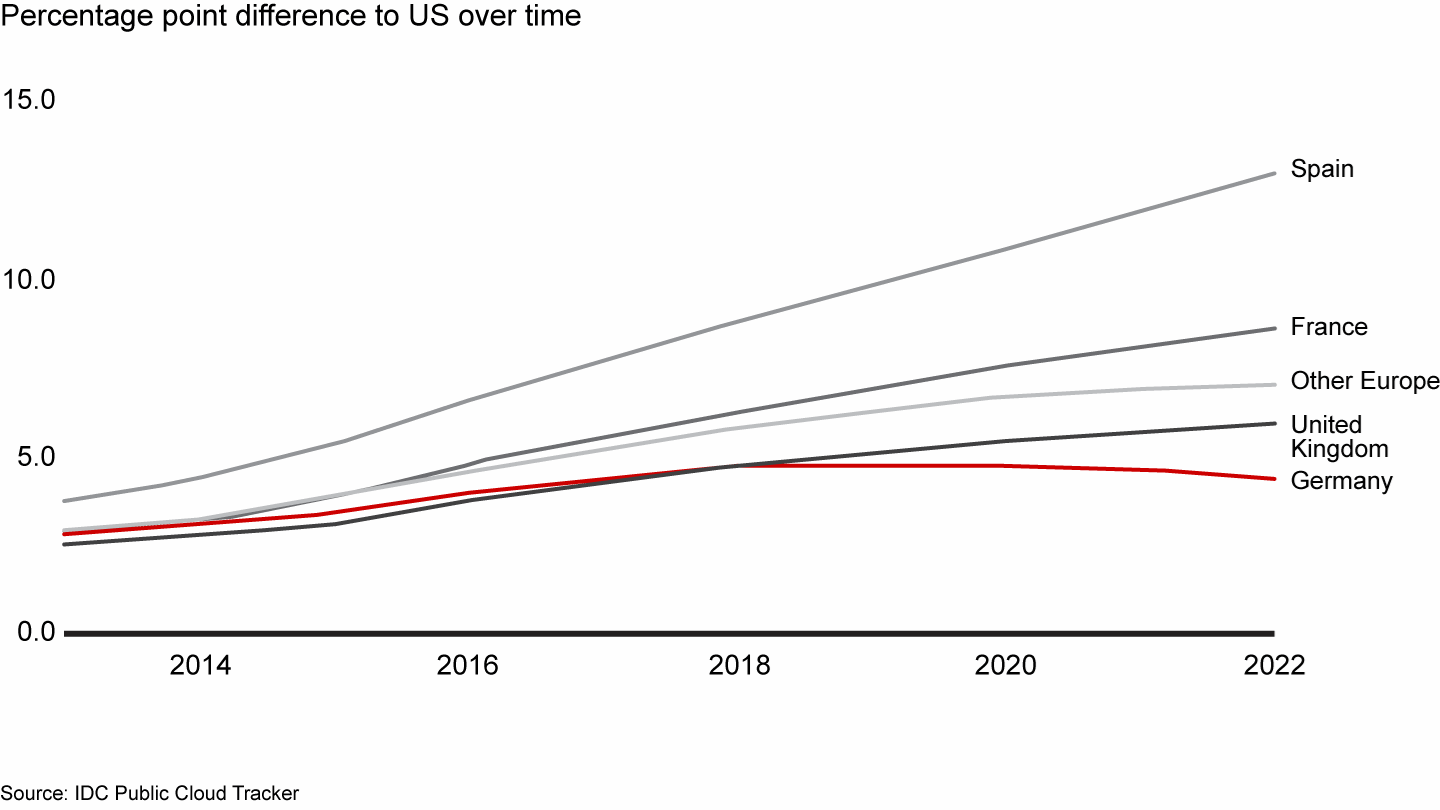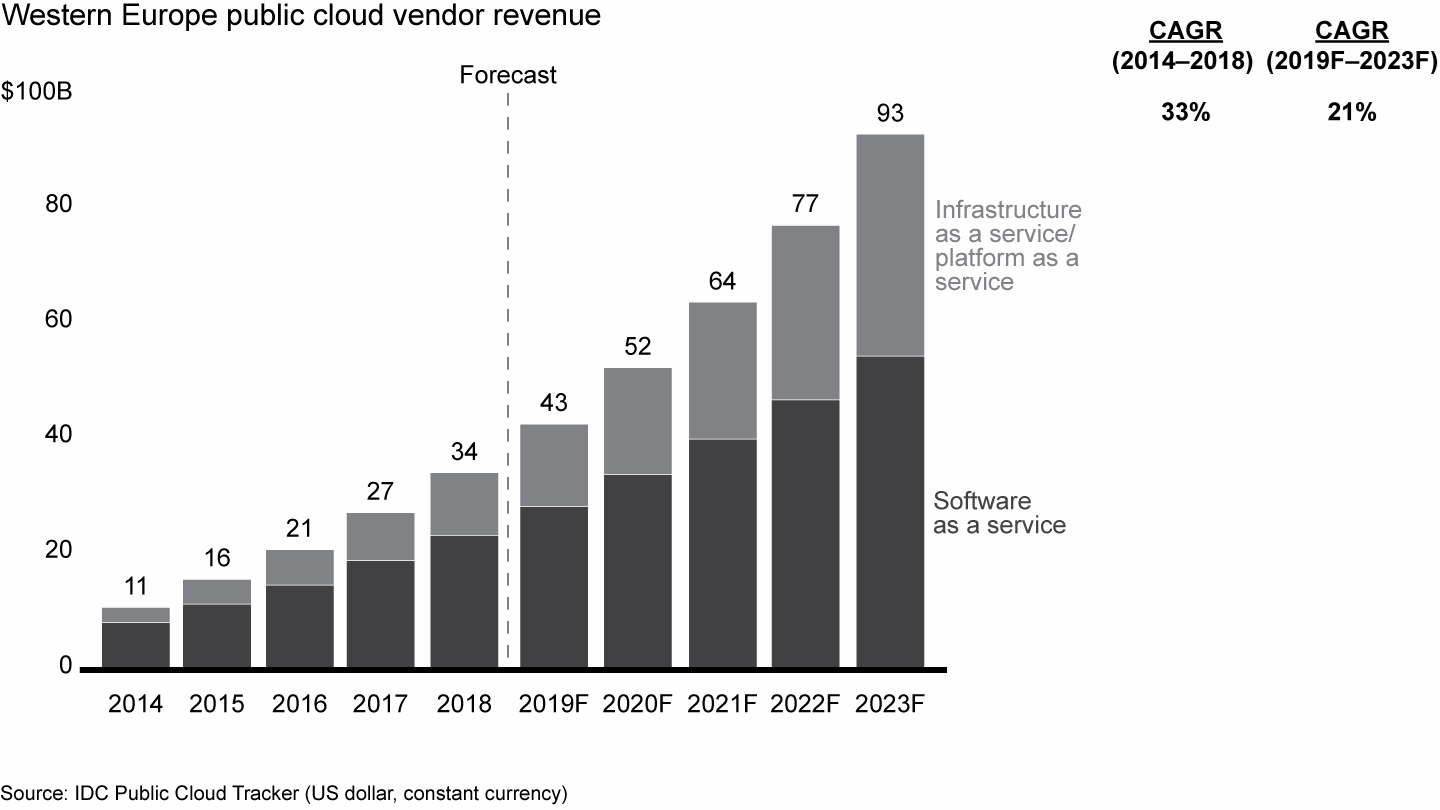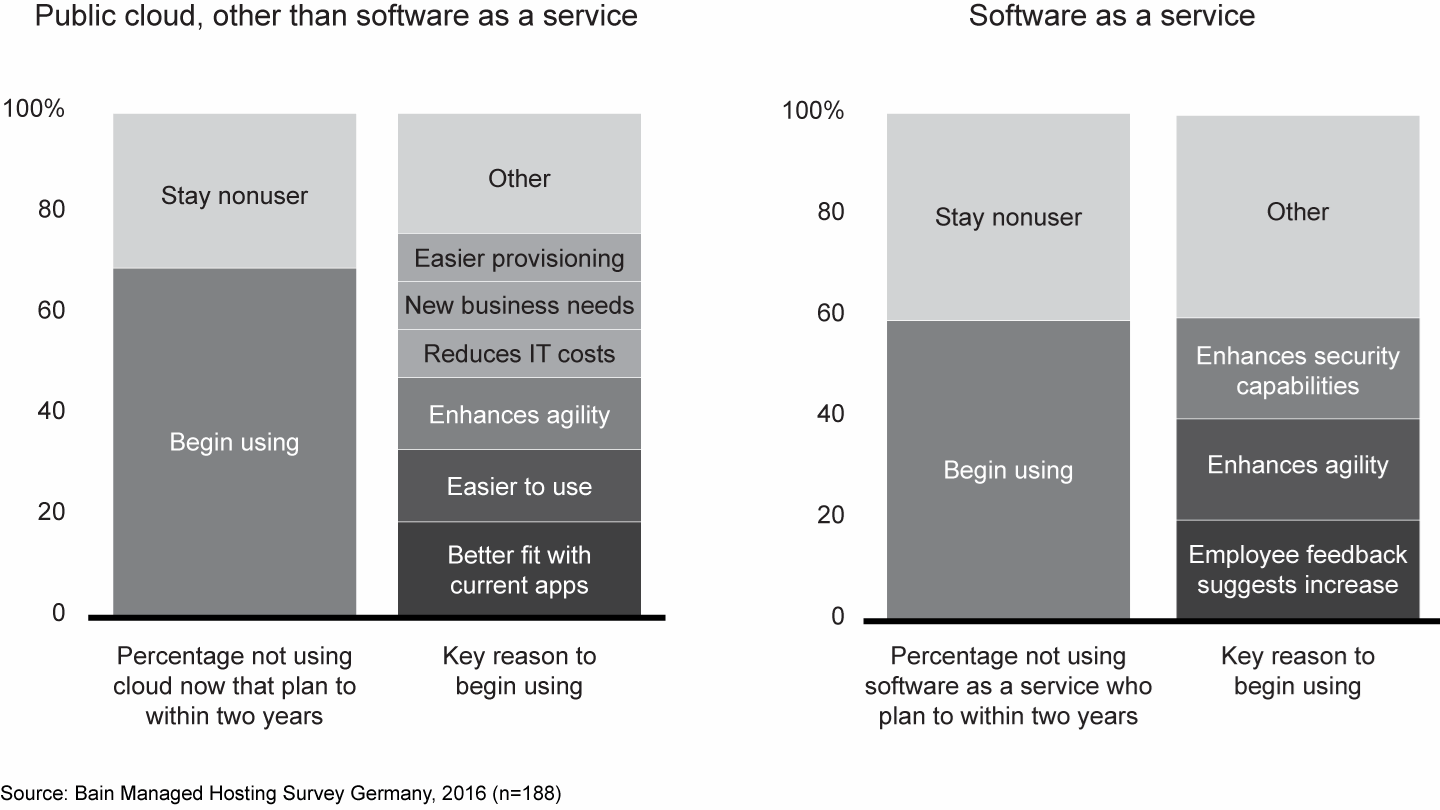Article

This is the fourth in a series of posts on the enterprise cloud market—its economics, customer segments and the opportunities for technology providers.
Spending on public cloud hardware, software and services in Europe lags behind spending in the US by several years. But the conventional wisdom on why that is misses a couple of critical points.
European markets trail the US in cloud adoption, but Germany appears poised to begin closing the gap over the next few years


First, European countries vary in how far behind the US they are in deploying workloads to the cloud. Companies in Germany and the UK are not far behind, only a couple of years behind in their percentage of total IT spending going to public cloud vendors. France and other countries lag further behind, and Spain isn’t expected to reach the 5% mark until about six years after the US did (see Figure 1).
Second, much of the commentary about why Europe’s companies are spending proportionally less on the cloud focuses only on the demand side. Conventional wisdom holds that Europeans are more concerned about privacy and security (or the dominance of US providers) and that this slows the region’s deployment to the cloud. But supply is also a big factor in cloud growth. Growth for cloud vendors tends to rise after they build big data centers within countries, suggesting that company sentiment about deploying to the cloud may not be so different from that in the US after all.
Significant opportunities remain for major cloud service providers and other technology vendors. Western Europe’s public cloud market could reach $43 billion in 2019, and it is expected to grow at about 21% a year, driven by continued increases in IT spending and a trend toward outsourcing (see Figure 2).
Public cloud revenue in Europe could reach $43 billion in 2019, and it is expected to grow at 21% annually


In addition to the supply constraint, three demand-related issues also appear to be slowing adoption rates in Europe.
- Industry mix: One is that Europe’s economy is more heavily concentrated in industries that have lower rates of cloud adoption. For example, Germany’s economy is heavily weighted toward industrial and manufacturing businesses, and Spain's market comprises many small and medium-sized businesses that are less likely to demand public cloud technologies. By contrast, the US is heavily weighted toward technology and professional services—industries that have been quicker to embrace cloud.
- Security and privacy concerns: Regional differences regarding data security and privacy still play a role. Strict regulations, such as the General Data Protection Regulation (GDPR) in Europe and sector-specific regulations in the US, inspire confidence in the cloud. But many European firms are still reluctant to adopt cloud technology because of concerns about data security, particularly when data centers might be located beyond national borders. As confidence in cloud security grows, however, these attitudes may shift, particularly in Germany.
- Homegrown: Companies in the US may be more comfortable with the cloud because the biggest cloud service providers—namely, Amazon Web Services (AWS), Microsoft Azure and Google Cloud—and most of their data centers are based there. Recently, Germany, France and the UK have all seen increased investments in data centers after the arrival of hyperscale players, though the uncertainty around Brexit could dampen cloud growth for UK companies.
In Germany, most of the companies we surveyed that were not already using public cloud or software as a service said they intended to begin doing so within two years


As noted above, adoption rates differ from one country to the next, with some leaders eagerly adopting cloud economics while others make more tentative moves.
- Germany is the second-largest data center hub in Europe, and it was the first European country to see the biggest cloud service providers set up shop. AWS opened a data center in Frankfurt in 2014, followed by IBM in 2015, Microsoft Azure in 2016 and Google in 2017. In addition to the EU's GDPR data privacy measures, Germany has instituted its own national measures to bolster data security certification and testing, including the adoption of Cloud Computing Compliance Controls Catalog (C5) certification, which sets a minimum baseline of data transparency and security for the public sector adopting public cloud. Our research found that among German companies not already using software as a service or public cloud applications, most planned to begin deploying the tech within two years (see Figure 3).
- The UK is the largest data center hub in Europe, and public sentiment toward cloud remains positive, with more than 90% of British companies using cloud technology in some capacity. Small and public sector organizations have bolstered adoption rates. AWS and Microsoft Azure opened their first UK data centers in 2016, followed by IBM in 2017. The UK will almost certainly adopt measures similar to GDPR upon its departure from the EU, but even so, the possibilities of future deviation and lack of cohesiveness with other European systems raise questions about future adoption rates.
- France trails the UK in terms of percentage of GDP spent on digital and cloud technologies, but it is in line with the percentage that Germany spends. France is Europe's third-largest data center hub. IBM opened its first SoftLayer site in Paris in 2015, AWS followed in 2017, and Microsoft Azure opened four data centers in France in 2018. France’s public sector faces greater hurdles than its European peers, with an IT infrastructure that is less centralized and a limited budget for cloud migration initiatives. Recently, the French government reduced taxes on data centers to encourage cloud investment, and a 2018 Paris convention on cloud delivered a detailed plan to move the IT systems of all French administration to the cloud.
- Spain lags behind Germany, France and the UK in terms of percentage of GDP spent on digital and cloud technologies. The large cloud service providers have been slow to set up shop: IBM opened a data center in Barcelona in 2015, but AWS, Microsoft Azure and Google have yet to establish data centers in Spain. Spain's attitude toward cloud adoption is more reserved because its enterprise market is much smaller than the enterprise markets of other leading European players. Spain's smaller enterprises are less likely to adopt cloud technology because of migration complexities, greater specialized support demands and less need of the benefits of scale. Spanish cloud providers may decide to expand by consolidating a relatively fragmented industry and providing a specialized service in which the hyperscale players fall short.
Europe is a top priority for large technology vendors, but it’s important not to treat it as a single market. Important national differences remain, and vendors will need to understand the differences among these competitive environments in order to make smart strategic decisions.
Mark Brinda and Kate Woolley are partners with Bain & Company’s Global Technology practice. Both are based in New York.

Mastering the Cloud Economy
Technology providers selling cloud software, services and hardware can strengthen their value proposition by developing a better understanding of cloud economics, customer preferences, and the impact of the cloud’s ascendance in legacy and disruptive technologies.